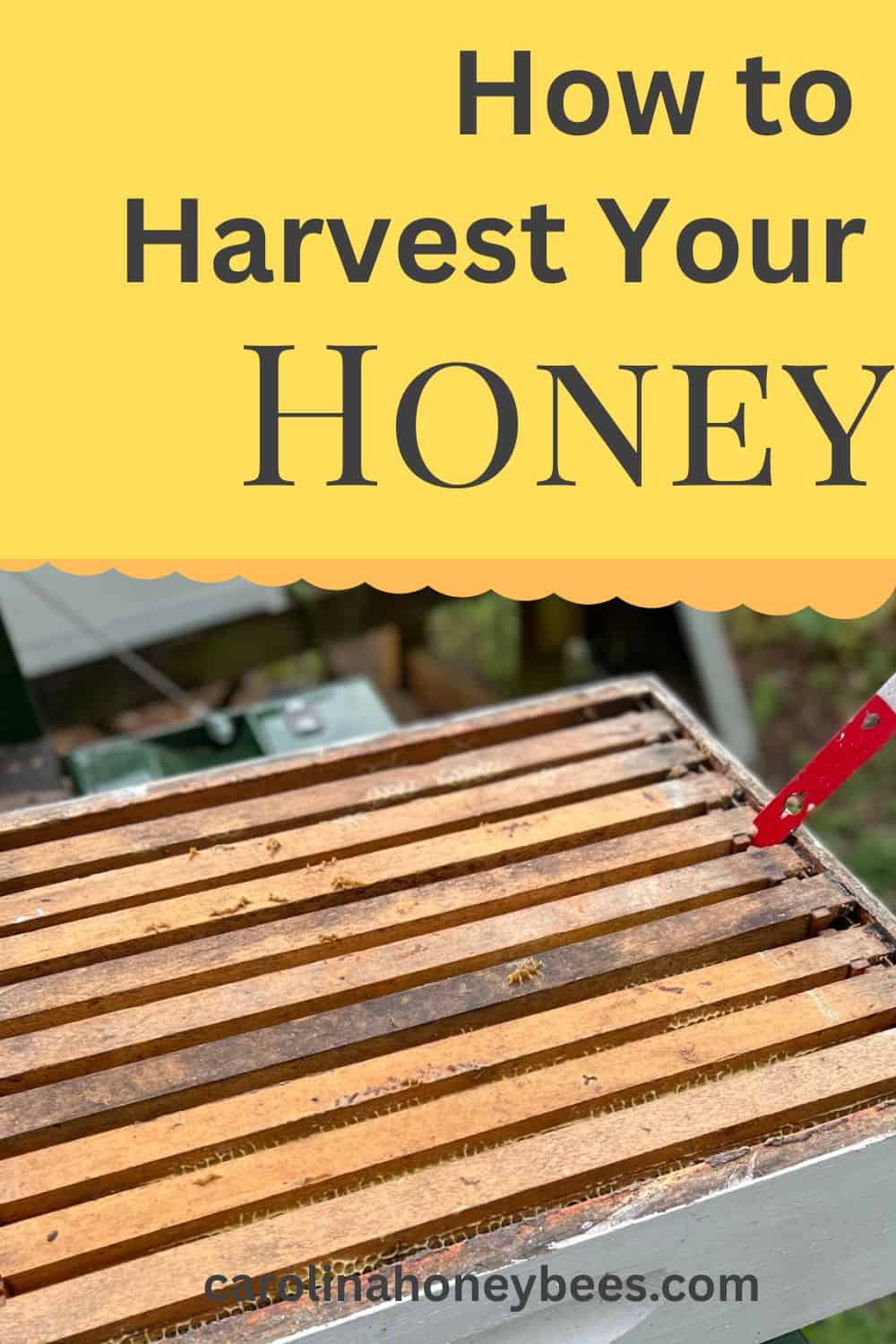Harvesting Honey From Bees
The dream of harvesting honey from your own beehives is one of the most common reasons for becoming a beekeeper. But knowing exactly when and how to do it can be a challenge for beginners. Timing is critical – not too soon or too late. In this guide, you will walk through the basic steps of how to harvest honey with minimal equipment. With a little knowledge and the right tools, you’ll be ready to bring in the harvest.

The harvest season is what makes all those tedious months of beehive management worthwhile. Both the bees and the beekeeper (me – you) have put in a lot of work. We hope to now enjoy the sweet rewards.
Is the Honey Ready to Harvest?
Before you get too excited about “jarring up” your honey crop, you have a few things to consider. Is the honey ripe? In other words, you must understand how bees make honey – is the process complete?
Worker bees collect plant nectar from thousands of flowers. But, there is a big difference between nectar vs honey. Nectar is very watery and would spoil in the hive. It will spoil in your jars too.
The water content in honey that has been made by bees is much less than that of raw nectar. It is shelf stable to store for a long time.
In most cases, workers will cap each honey cell with a thin wax covering when it is ripe. It is these capped honey frames that are collected from the hive.
This post may contain affiliate links. As an Amazon Associate, I earn from qualifying purchases. Please read my disclosure.
How Much Honey Can You Take?
Your beekeeping adventure will not be successful unless your bees are able to survive Winter. To do that, they need to be a strong healthy colony with plenty of food (stored honey).
How much honey does a hive need? The amount varies greatly from one region to another. Around 60# of excess stored honey is the average. Hives in colder regions will need more.
In my area, (south – but some cold months) my bees do well one deep box and and 1 shallow full of honey – but I closely monitor food levels throughout Winter. Other beekeepers use mediums or double deeps.
Tools Needed
The tools used by beekeepers for honey harvesting depends on the size of the apiary and the wallet size of the beekeeper. There are many things you can buy to make the job easier – but they are not essential.
You need some type of protective beekeeper clothing – as your colony may not be excited about giving up their hard work. Well, they may be excited in a way that you will not enjoy.
A hive tool is necessary to separate boxes and remove frames. I always take my beekeeper’s smoker with me. However, I do not use it during honey collection.
Because of the way smoke affects bees – I feel it is a hindrance instead of a help in moving bees out of the boxes.
In addition – depending on your process you may need:
- bee escapes (or an escape board)
- a bee brush or blower
- frame grips
- fume board / and spray
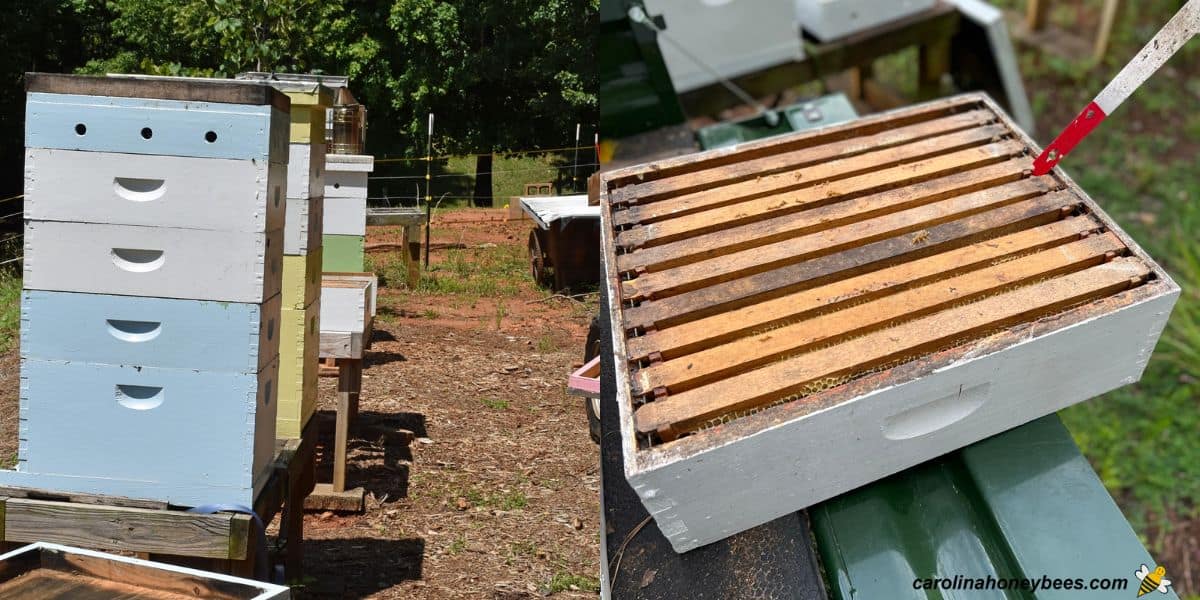
Preparing to Harvest
The best time of day to harvest honey is on a warm sunny day when most of the foragers are out working. The worst time of day is late in the evening when all the older bees are home.
Try to avoid days of inclement weather as they tend to make bees cranky. Also, is common for late season colonies to be strong – and you may find more aggressive honeybees than normal.
The honey crop may be located in various size beehive boxes or supers – but shallow honey supers are most common.
Consider how you plan to transport those heavy boxes back to your honey house or secure “inside location” as quickly as possible.
Removing Honey Frames from the Hive
It is normal to feel a bit overwhelmed, but taking supers off the hive can be a lot of fun too. All of these items can be used to remove bees from the honey supers:
- use bee escapes
- remove bees with a blower
- use a bee brush frame by frame
- use a fume board
Bee Escapes
Beekeepers in cooler regions may use “bee escapes” to separate the bees from the honey. This is a small plastic one way gate that fits in the hole of an inner cover. (There are several styles). Bees are able to leave the super but not return.
Useful for late season harvests in cool regions, this does not work in my area because the temps are hot at night and bees remain in the honey supers.
Escapes also require opening the hive twice (once to place them – between the boxes for harvest and the rest of the hive – and the next day to remove the honey boxes).
One consideration – If you live in an area with Small Hive Beetles you risk them infesting the unguarded super. Overnight should not be a problem but don’t leave them in place for days.
Using a Bee Blower
A beekeeper with many hives may use a leaf blower to blow bees out of the honey supers. The honey super is removed from the hive and placed on it’s end on a stand or pickup tailgate.
The blower removes bees by blowing them off the comb. This method is a bit too exciting for me but it works if you need to harvest a lot of boxes. A bit messy for smaller scale beekeepers in my opinion.
Bee Brush
A bee brush is a useful tool for many beekeeping activities. If you have just a few boxes of honey to collect, set the box off the hive and then gently brush the bees from each frame.
This works well-but the bees do not like it. If you want to use your brush, have an extra box with a tight lid nearby. After brushing the bees off a frame you can place it in the tight box.
I don’t use a brush alone but rather in combination with another technique during harvest time.
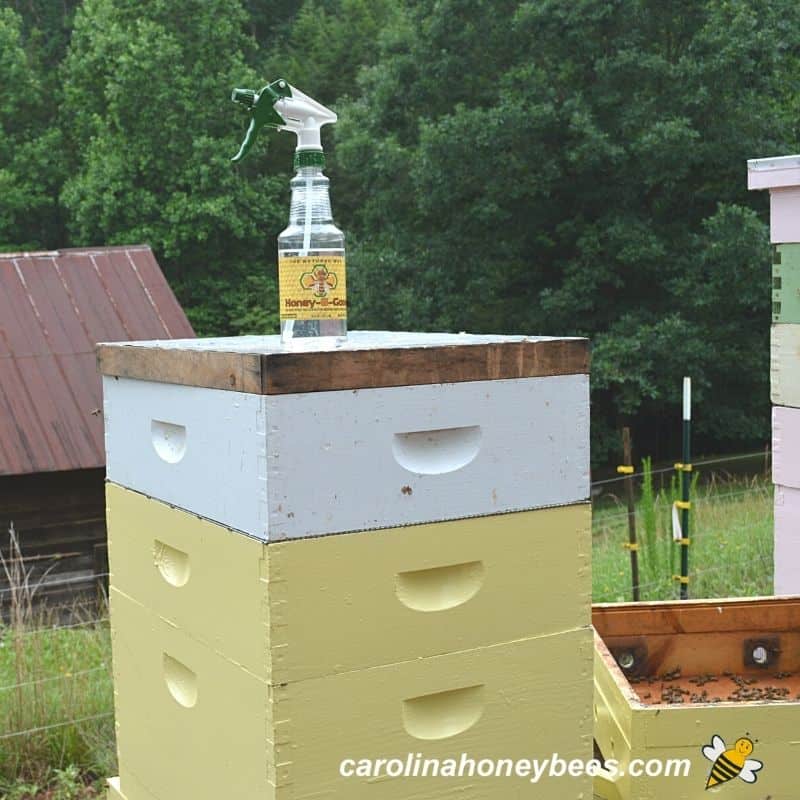
Fume Board & Liquid
The use of a fume board is the most common method for small scale beekeepers. A special non-toxic liquid is sprayed on the inside of a special top that contains absorbent material (flannel or burlap).
The bees react to the odor by moving away, leaving the top super almost bee free after a few minutes.
This is my favorite way of harvesting honey but you must have a bit of patience. It takes a few minutes for the bees to move – fume boards work better on warm sunny days.
Several liquid sprays are available – one of the old formulas works very well but smells like dead things – I do not use it.
The almond/cherry scented products smell good and work well. I would choose either – Bee Quick, Honey B Gone or other pleasant scented removal liquid. You only need to use a little – a couple of pumps inside the fume board lid works well.
The Process of Collecting Honey
Every beekeeper has a favorite way of collecting honey from their hives. Do what works for you. This is my process.
Harvest takes place early in the morning, while the foragers are out working – hopefully. My tool box contains:
I also have an super box. It is made “bee-tight” by using 2 hive tops.
Turn an outer cover upside down and the empty super box fits inside. A second outer cover (or piece of wood) sits on top of the empty box. This keeps visiting bees out as I place honey frames in there.
Step by Step
1. Spray a small amount of (removal) liquid on the inside of the fume board. A “X” shaped pattern is good. You do not have to use very much – don’t try to soak the fabric.
2. Gently open the hive (no smoke), remove the outer cover and inner cover of the hive – set aside. Now, place the fume board (that has been sprayed) on top of the first honey super to be removed.
You will hear an increased buzzing. In a few minutes (8-10) the majority of the bees will leave the super and go into the box below. It works faster on a sunny day.
3. When most of the bees are out (you can check by lifting the fume board to peek in), remove the honey super from the hive and set it on a nearby stand.
**If you are tall enough – you can remove the frames one by one and not remove the heavy super. I like to set the whole box off when I can but its your call. I place the top of inner cover back on the hive loosely to keep the bees calm.
4. Using a hook hive tool (my favorite), and a pair of frame grips (if you wish) – remove each frame. Gently brush off the few bees remaining and place the frame in your bee-tight box.
As you do this, do a quick check to ensure there are no baby bees on the frame. Some beekeepers use queen excluders to help keep brood out of supers. But, it is still a good idea to check.
Continue the process until you have removed all of the capped honey frames in your first box. Repeat the process if you have another box of capped honey to collect from the hive. Then, close up the hive.
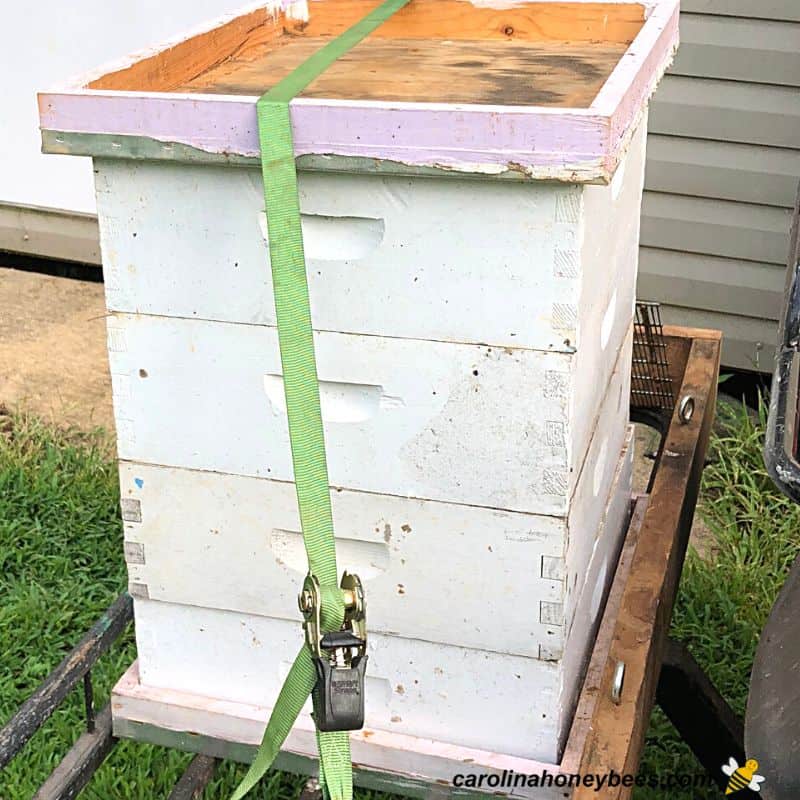
Have an Escape Plan
Take your harvest away from the bee yard quickly. You do not want it to attract the attention of other bees! They may take it back…LOL
The boxes may be very heavy. Consider having an ATV, wheelbarrow or truck bed to help you get your supers under cover.
Many beekeepers do not have the option of processing their boxes the same day. Place them in a bee-tight space that is protected from pests such as ants.
The garage is not a good option if bees can get in – they will smell the honey and you will have thousands of girls waiting outside the door.
Some beekeepers have a dedicated honey house to keep the boxes until ready for the next step. While it is not necessary to have a dedicated building you do need some place clean and safe.
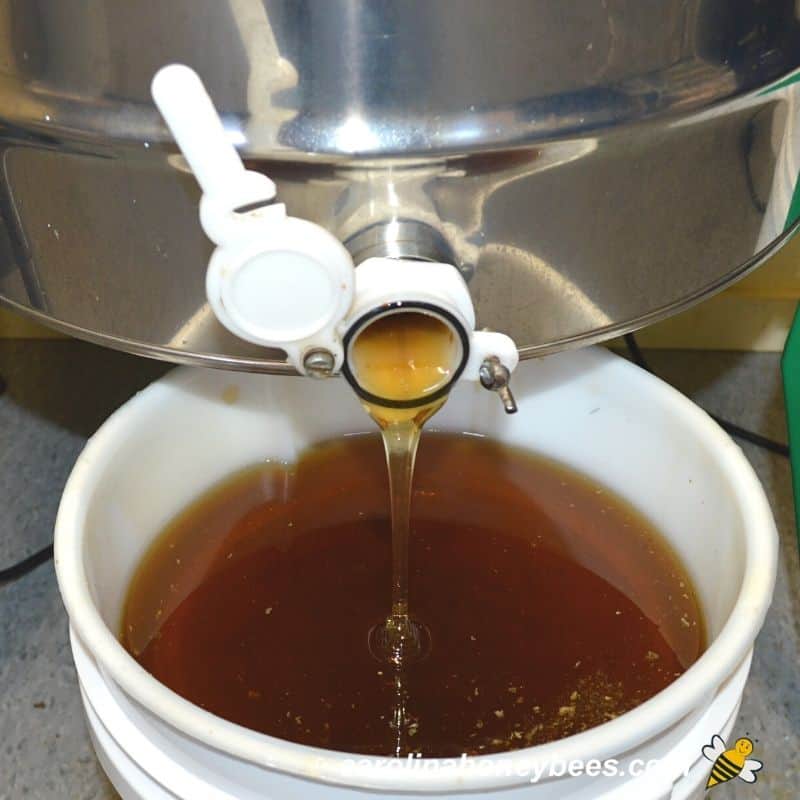
Make Plans to Process Your Honey Harvest
Don’t delay completing your honey harvest. If, you live in an area with Small Hive Beetles – they can ruin your boxes of honey in just a few days. Even if you do not see any adult beetles, the eggs may be there.
You may choose to separate honey and comb using a machine. Learning how to extract honey is a simple process.
The allows the beekeeper to harvest liquid honey and have empty comb for the bees to reuse. There are several styles available but a honey extractor is not mandatory. The crush and strain method has been used for hundreds of years.
What to do with Uncapped Honey Frames
Usually, uncapped honey frames should be left in the hive another week or two. Bees cap cells when the honey is ripe – a moisture content of about 18.6%
Can your frames be uncapped and still ripe and ready to take? Yes! I have had some years when the nectar source was abruptly cut short by weather conditions and the bees did not finish capping.

Most beekeepers keep a honey refractometer on hand to measure the moisture levels. Check a few cells of your uncapped frames.
Cleaning Up & Storing the Harvest
If you used an extractor to process your honey, you will have some valuable drawn comb to reuse. Depending on the number of honey flows in your region, they may go back on the hive.
Otherwise, be sure to store your honey supers properly for Winter to protect them from wax moths and other pests.
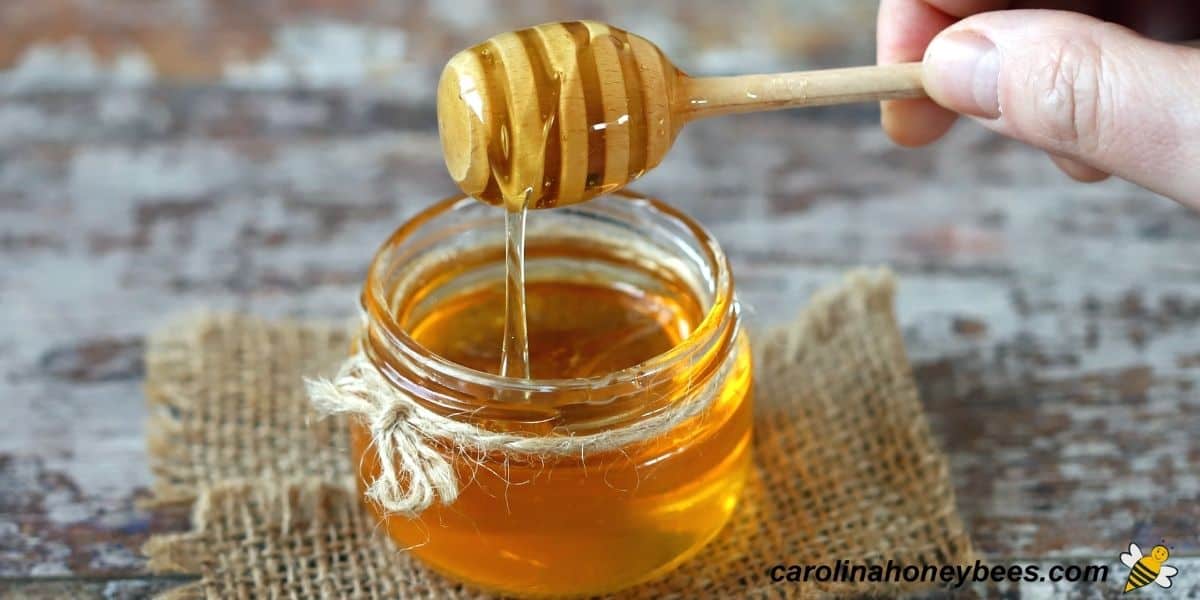
Now, what to do with all that beautiful extracted honey? Thankfully, raw honey is easy to store. If you have a lot, you will probably store it in 5 gallon buckets with an air-tight seal.
Smaller producers usually bottle up honey into quarts or smaller jars. You may choose jar or various sizes and bottle only liquid honey. Or larger glass jars of chunk honey may be your favorite.
Especially if you plan to sell product, be sure to have a proper label. In my honey labeling guide, I cover the key elements that need to be in place on every label.
Unless you consume or sell the honey quickly, some of it will likely crystallize. Do not panic if your honey “turns to sugar”. This is a natural process and honey can be decrystallized with ease.
FAQs
In most areas, bees do not make honey all year. It is the warm months that these insects work tirelessly to store food for the cold season ahead.
When starting a new hive, it may be the second year before your bees are able to produce a crop for you. This depends on local foraging conditions and climate of course.
Harvesting does not hurt the bee colony – as long as you do not take too much. Don’t be greedy. Always leave the bees enough food for Winter.
No bee smoker is required at harvest time. In fact, it might make the job more difficult.
Final Thoughts
If you have colonies that were started this Spring from scratch, you may not get a honey harvest the first season. I know, I know – its difficult to wait a whole year. Also, keep in mind that not every colony makes excess honey every year. This is an honest (if sad) truth.
I always tell students in my online beekeeping class, ” nothing will ever taste better than honey from your own beehive”. Make the most out of every drop.

